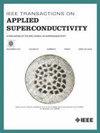IF 1.7
3区 物理与天体物理
Q3 ENGINEERING, ELECTRICAL & ELECTRONIC
引用次数: 0
摘要
光子和超导平台是现代量子技术的核心。然而,现有的大多数超导体都是不透明和高吸收性的。通过电化学插层还原的氧化铟锡(ITO)薄膜为可见光、近红外和中红外光区的可调超导性和透明度提供了一种前景广阔的解决方案。要开发利用电磁波与量子态相互作用的设备,了解 ITO 表面电化学反应的机理和新出现的超导态的维度是至关重要的一步。在这里,我们研究了三种调节 ITO 薄膜电荷密度的途径,它们可能会导致超导态的出现:掺杂异价原子;电化学插层;以及合成缺氧的 ITO 薄膜。第一种方法在任何掺杂水平下都不会显示出超导性,而第二种方法则会在 ITO 表面产生二维超导性,第三种方法则会在主体中产生三维超导性。本文章由计算机程序翻译,如有差异,请以英文原文为准。
Transparent Superconductor on the Base of In2-ySnyO3-δ: Unraveling the Electrochemical Doping Mechanism
Photonic and superconducting platforms are at the core of modern quantum technologies. However, most existing superconductors are opaque and highly absorptive. Indium-tin oxide (ITO) films reduced by electrochemical intercalation provide a promising solution for tunable superconductivity and transparency in the visible, NIR, and mid-IR optical regions. Understanding the mechanism of electrochemical reaction at the ITO surface and the dimensionality of the emerging superconducting state is a crucial step in developing devices that utilize the interaction of electromagnetic waves with a quantum state. Here we studied three routes to tune the charge density in ITO films, that might lead to the emergence of the superconducting state: doping with heterovalent atoms; electrochemical intercalation; and synthesis of oxygen-deficient ITO films. While the first does not show superconductivity at any level of doping, the second induces two-dimensional superconductivity at the ITO surface, and the third route creates three-dimensional superconductivity in bulk.
求助全文
通过发布文献求助,成功后即可免费获取论文全文。
去求助
来源期刊

IEEE Transactions on Applied Superconductivity
工程技术-工程:电子与电气
CiteScore
3.50
自引率
33.30%
发文量
650
审稿时长
2.3 months
期刊介绍:
IEEE Transactions on Applied Superconductivity (TAS) contains articles on the applications of superconductivity and other relevant technology. Electronic applications include analog and digital circuits employing thin films and active devices such as Josephson junctions. Large scale applications include magnets for power applications such as motors and generators, for magnetic resonance, for accelerators, and cable applications such as power transmission.
 求助内容:
求助内容: 应助结果提醒方式:
应助结果提醒方式:


